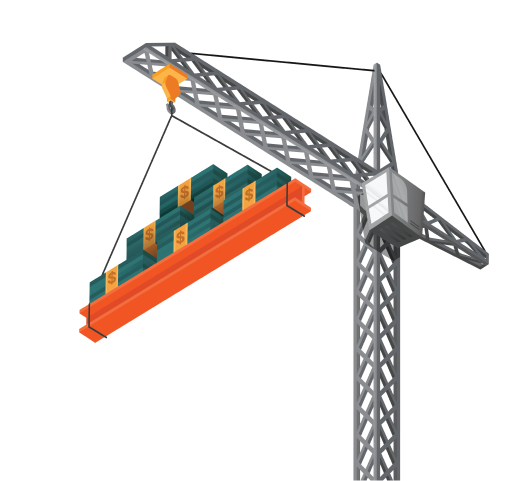— 9 min read
Revenue Recognition in Construction: Accurately Monitoring Financial Health
Last Updated Mar 13, 2024

Revenue recognition is an accounting principle that refers to how and when a company accounts for its received payments. It’s generally a company’s first step in measuring profitability and monitoring its financial health. How companies recognize revenue impacts how and when they get paid, their tax liabilities and the accuracy of their income statements.
This article will discuss accounting standards for the revenue recognition process, contractors' challenges and best practices for getting it right.
Table of contents
Understanding Revenue Recognition
Revenue recognition is the accounting process of determining the periods in which income, or revenue, should be recognized and reported on the financial statements. In other words, invoices for work completed are recognized as revenue as the contractor incurs expenses on the project rather than when the contractor receives the payments for work completed.
Here’s an example of how revenue recognition works: When a client gives a contractor a down payment for an upcoming project on a cash accounting system, the cash is recognized as income immediately. The contractor's method of revenue recognition will determine when this cash deposit can be recognized as earned income and reported on the income statement. The way a company goes about figuring this out is important because it can impact how clear a picture the company gets about its financial health and progress.
Percent complete is generally used on large projects spanning several accounting periods. The dollar value may or may not be large, but the key is when the revenue can be recognized across the lifespan of the project. Time and materials payments are another method of revenue recognition used on service-based contracts where the scope is not well-defined.
No matter which method a company uses, it's important to have a set standard to work by so that the results are uniform.
A Framework for Developing Revenue Recognition
The Accounting Standard Codification (ASC) 606 is a standardized, step-by-step process of developing a revenue recognition strategy. ASC 606 is a framework for identifying the services provided within a contract, and how revenue will be recognized over the life of that project. The five-step process the ASC sets out is as follows:
- Identifying the contracts
- Identifying performance obligations
- Determining the transition price
- Allocating the transition price to the performance obligations
- Recognize revenue
The ASC 606 sets guardrails for quantifying cost estimates and contract types so that all parties recognize revenue in the same way. This is particularly important in construction, where multiple factors can complicate the recognition process.
Consider a contracting firm billing for work according to its estimates of percent complete on a project. That firm could potentially manipulate the reporting process for financial benefit by making it appear there was a much higher margin during periods when a bonus will apply.
How to Use Revenue Recognition
Revenue recognition can be used within many contract frameworks to regulate accounting practices.
Percent Complete
Percent complete is a model of revenue recognition that a contractor and owner will use when the entire scope of a project is determined and the price is fixed. The contractor estimates and then bills the client for a specific set of deliverables, like square feet of concrete, based on the amount of time it usually takes to do that work.
When the contracting firm has made some progress on that project, it can bill based on the percentage of completed square feet, figuring out what percent of the work is complete and what percent of the project cost has been incurred.
Milestone Revenue Recognition
Milestone revenue recognition in construction refers to a method of accounting where revenue is recognized upon reaching certain predefined points or events in a project, known as milestones. Unlike other revenue recognition methods that may recognize revenue based on time elapsed or costs incurred, milestone revenue recognition focuses on completing specified, measurable events or achievements within the project's scope.
Complete Project
In some cases, smaller contractors can wait to recognize the revenue on the project until the entire project is delivered and closed out. With this accounting method, a contractor can still bill for payments throughout the project but will not list the revenue and expenses on a balance sheet until the end of the project.
The federal government imposes rules on which contracting firms can use the complete project accounting method, and under which circumstances.
Time and Materials (With a Cap)
Time and materials contracting is most commonly used with service-based contracts where the scope is not entirely clear. A good example might be a homeowner who pays a landscaper to clear a backyard without really understanding what's involved or how long the work will take.
When a contractor bills an owner based on time and materials, the contractor's profit margin is built into the hourly price. For instance, the contractor understands that the cost to put a particular person on the job is about $120 per hour, including the worker's hourly rate, plus overtime costs, health insurance and any other costs associated with that labor.
The contractor will then charge the owner at a higher rate to allow for profit on that exchange. At that point, the contractor doesn't have to worry about percent completion — they can just bill for the hours the worker is on the job.
However, if the time and materials contract includes a cap on the payments — for instance, to protect the owner from a very high contract total — it's possible the contractor will receive regular payments until the total reaches that cap, and then have to continue working while receiving no payment at all. Percent complete may be used as the revenue recognition method over the course of this project to help offset revenues and costs accordingly.

Why Revenue Recognition is Important
Revenue recognition helps contractors develop a steady and ongoing method of measuring their business' earnings. It also keeps construction businesses honest about their earnings.
Creating a Standard Measure of Performance
By standardizing revenue recognition, a business creates a reliable measure of its performance. When a contracting firm doesn't have a solid grasp on its revenue recognition method — or if that method changes month-to-month or quarter-to-quarter — the financial statements can become skewed and difficult or even impossible to compare across several periods, diminishing their value.
Having standardized accounting can bring everything into focus: Contractors can track their margin percentages to compare the profits earned on projects over time. For example, say a business was making consistent 15% margins on all its contracts from 2015-2017, only notice in the past year the margins were closer to an average of 6%.
If the accounting methods haven't changed, the contractor knows those numbers are accurate and needs to evaluate current practices to determine the root cause of the margin fade.
Revenue Reporting and Responsible Accounting
Without a good framework for determining the value of contracts and cost estimates, a company could fudge its numbers — showing a significant loss at the end of one year and shuffling profit into the following year.
For instance, a company could estimate lower profit margins across the life of several projects in anticipation of a large loss on a single project. By manipulating their cost estimates — therefore delaying revenue recognition — they can time the recognition of the upside-down job's loss to coincide with a fabricated "windfall" of increased margin on other projects.
In this example, the users of the financial statements would not realize such a large loss had occurred — unless they looked deeper into the underlying support documentation, like the WIP schedule.
Revenue recognition offers a standard framework for contractors to use to avoid these types of workarounds.
Understanding Profit
Revenue recognition helps contractors better understand their own business finances better, by offering a clearer picture of the revenue and expenses they earn.
Consider a general contractor who hires a subcontractor to help complete some work on a project. Once the project is complete, the general contractor receives payment for the work and recognizes the revenue right away on the accounts.
However, the contractor has not received an invoice from the subcontractor and has no expense to offset the earned revenue, creating big variations on the income statement from month to month. The variations make it really difficult for a company to compare income statements and understand progress over time.
By comparing the total actual cost to date to the updated estimate of total cost to complete the project, a contractor can determine the percentage of completion on the project The percentage of completion is then applied to the total contract value to determine how much revenue can be recognized to date- or how much "earned revenue" the contractor can now recognize.
When a contractor uses a cash basis for recognizing revenue, the money can ebb and flow very drastically on the income statement month over month. Large variations make it more difficult to determine the health of the business over time, which can impact the ability to get loans and surety bonds and make strategic decisions about the firm's investments.
Illuminating Real Cash Flow
When recognizing revenue based on percent complete, it's important that contractors understand their contracts fully, and remember the nature of the construction business and the expenses they're accruing over time so as not to misconstrue their margins on a project.
Consider a project for which a contractor estimated 10% margins. During the project, it appears as if the firm is realizing 20% margins on the work. Recognizing that increased profit margin by decreasing the total cost estimate without understanding where it's coming from can leave the contractor with negative margins on the project as it progresses. Having a set revenue recognition method for the project can help clear things up before the contractor makes decisions that could impact cash flow.
Learn more: Managing Cash Flow in Construction
Driving Contract Strategy With Revenue Recognition
When determining how to structure a contract, estimators have a few options available. For example, a dirt-work contractor may agree to remove topsoil on a project hourly or a set unit price based on the total cubic yards of topsoil to be removed.
On an hourly project, the client may face costly delays due to rocks or clay in soil, but the contractor is guaranteed a margin as long as the equipment is moving. On the unit price contract, the client knows they will pay a certain amount per CY of soil removed, regardless of how long the contractor has to work at it.
Suppose the contractor is using a consistent method of revenue recognition based on estimated cost. In that case, the latter scenario becomes a little less risky to the contractor. By consistently measuring the performance of their project against their estimates, the contractor can identify when margins are slipping and request change orders to account for the increased cost of removing unsuitable material.
Categories:
Tags:
Written by
Kelsie Keleher
9 articles
Kelsie is a Senior Strategic Product Consultant for general contractors at Procore; working closely with civil and infrastructure clients. Kelsie holds a Masters of Business Administration (MBA) and has close to a decade of experience in construction accounting and finance.
View profileKristen Frisa
26 articles
Kristen Frisa is a freelance writer specializing in finance and construction technology. She has helped numerous companies to provide value to their readers and establish their expertise in their industries. Kristen holds a degree in philosophy and history and a post-graduate certificate in journalism. She lives in Ontario, Canada.
View profileWin More Work
Get discovered for relevant work on the Procore Construction Network.

Explore more helpful resources

Navigating Obstacles in Construction Cost Management
The financial stability of construction firms often hinges on their ability to effectively manage costs, a key factor in keeping projects within budget and securing profitability. The process of cost...

Construction Project Over Budget? Common Causes & Solutions
On construction projects, going over budget is an all-too-common scenario. This situation is more than a mere miscalculation: It can fundamentally alter the trajectory and outcome of a construction project...

The Completed Contract Method of Accounting in Construction
Most construction companies earn revenue and pay job costs throughout the duration of each project. They record income and expenses using the Percentage of Completion method of accounting, which provides...

Financial Audits in Construction: How to Prepare for & Manage an Audit
Financial audits are not something people look forward to facing — the process is intended to find mistakes and weak points — but regular audits can improve the overall health...
